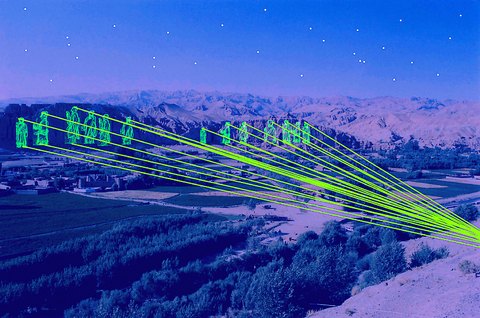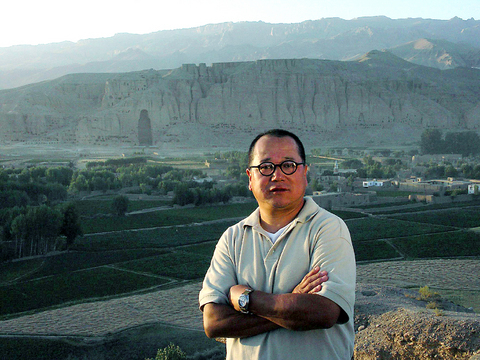Japanese artist Hiro Yamagata has announced plans to recreate Afghanistan's destroyed Bamiyan Buddhas using as many as 240 laser beam images, a giant project that could also bring electricity to local people.
The US$60 million exhibit, which is slated to begin in June 2007, will for several years replicate the images of the statues, which were the world's tallest standing Buddhas until the Taliban regime destroyed them.
"When I first visited Bamiyan, I was very impressed with the sights of valleys, as well as local children, local people," said the globally acclaimed artist, known for his large laser-beam art works.

PHOTOS: AFP
"Every time I go back, I feel the growing passion of wanting to create art there," he added.
Yamagata plans to show the images for two hours from sunset four days per week. He is still in negotiation with the Afghan government and local entities on how long the exhibition will last but it will likely be for years, he said.
The high-tech project to recreate the destroyed cultural assets could also be important for the local economy in one of the world's poorest countries.

To create the laser images, Yamagata plans to install 120 laser systems, 10 windmills and 11,988 solar energy panels.
Yamagata and the Afghan government anticipate the power generating systems would be able to supply about 100 watts for six hours daily to each household of the area which is still not being provided electricity.
Afghan ambassador to Japan, Haron Amin said the project could transform Bamiyan into a tourist destination. He called it an "eco-friendly, environment-friendly and energy-friendly concept."
The Islamic fundamentalist Taliban, ignoring world protests, dynamited the two 1,500-year-old statues carved into the sandstone cliffs of Bamiyan in March 2001, branding them un-Islamic.
The regime was ousted later that year in a US-led military campaign after the 9/11 attacks. In a parallel, the World Trade Center was represented by light rays in an artistic memorial after the twin towers were brought down by hijacked airplanes.
Afghan Minister of Information and Culture Sayeed Makhdum Rahin, attending a press conference in Tokyo with the artist, said the laser beams were an appropriate way to represent the destroyed statues.
"Three years ago when we had an international seminar on Afghanistan's cultural heritage, many people wanted to discuss reconstruction of Buddha statues ... I did not agree with the idea," Rahin said.
"Those statues belonged to a different generation, different time and different situation."
"I'd say let's keep the spaces the way they are. Let these spaces be witnesses for what human beings did to culture and history in the beginning of the 21st century," he said.
Yamagata said he would agree with the minister "even if I weren't an artist using lasers."
"We can't change the history of destruction, so I myself think it would be silly to build something new to replace them," he said.
He doubted governments would provide financial support. Instead, he plans to raise donations by throwing
charity parties and from non-governmental organizations and corporations.
He already has brought celebrities onto his project committee including Dennis Hopper, Sharon Stone and Canadian film director James Cameron.
Asked about security in Afghanistan, much of which is racked by violence by Taliban remnants, Afghan ambassador Amin called on foreigners to visit Bamiyan but warned them not to go through the Pakistani city of Quetta near the border.
Earlier this year two Japanese schoolteachers, reportedly on their way to Bamiyan, were shot dead on an Afghan highway linking Pakistan to the Taliban's former stronghold of Kandahar.

As I finally slid into the warm embrace of the hot, clifftop pool, it was a serene moment of reflection. The sound of the river reflected off the cave walls, the white of our camping lights reflected off the dark, shimmering surface of the water, and I reflected on how fortunate I was to be here. After all, the beautiful walk through narrow canyons that had brought us here had been inaccessible for five years — and will be again soon. The day had started at the Huisun Forest Area (惠蓀林場), at the end of Nantou County Route 80, north and east

Exceptions to the rule are sometimes revealing. For a brief few years, there was an emerging ideological split between the Democratic Progressive Party (DPP) and Chinese Nationalist Party (KMT) that appeared to be pushing the DPP in a direction that would be considered more liberal, and the KMT more conservative. In the previous column, “The KMT-DPP’s bureaucrat-led developmental state” (Dec. 11, page 12), we examined how Taiwan’s democratic system developed, and how both the two main parties largely accepted a similar consensus on how Taiwan should be run domestically and did not split along the left-right lines more familiar in

Specialty sandwiches loaded with the contents of an entire charcuterie board, overflowing with sauces, creams and all manner of creative add-ons, is perhaps one of the biggest global food trends of this year. From London to New York, lines form down the block for mortadella, burrata, pistachio and more stuffed between slices of fresh sourdough, rye or focaccia. To try the trend in Taipei, Munchies Mafia is for sure the spot — could this be the best sandwich in town? Carlos from Spain and Sergio from Mexico opened this spot just seven months ago. The two met working in the

This month the government ordered a one-year block of Xiaohongshu (小紅書) or Rednote, a Chinese social media platform with more than 3 million users in Taiwan. The government pointed to widespread fraud activity on the platform, along with cybersecurity failures. Officials said that they had reached out to the company and asked it to change. However, they received no response. The pro-China parties, the Chinese Nationalist Party (KMT) and Taiwan People’s Party (TPP), immediately swung into action, denouncing the ban as an attack on free speech. This “free speech” claim was then echoed by the People’s Republic of China (PRC),